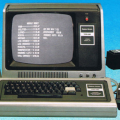Was the Model III created to replace the Model I?
The TRS-80 Model III, introduced in August 1980, is often described as a replacement for the TRS-80 Model I, introduced in August 1977. Considering that the Model I was discontinued just six months later due to its failure to meet new FCC regulations, it is easy to assume that the Model III was always intended to replace the Model I.
But Radio Shack showed no sign of any plans to discontinue the Model I after the introduction of the Model III. It remained in the catalog at a price $200 lower than the Model III. Jon Shirley, Vice President of the Computer Division at Radio Shack, wrote in his “View from the Seventh Floor” column in the September 1980 issue of the TRS-80 Microcomputer News:
First of all the Model I is not being dropped, it is in the 1981 Radio Shack Annual catalog and the price is unchanged.
He expanded his comments in his November 1980 column:
Yesterday I read an amazing article that stated that we had over 100,000 Model I’s stocked in our warehouse and had stopped production. That would sure come as a surprise to the over 200 folks who work at our Model I factory which is running at full speed. Our warehouse inventory is below normal at about a 30 day supply on hand instead of the 45 day supply we usually carry. So if you are waiting for some monster price cut to buy a Model I you will wait a long time as it is not in our plans.
But the story was different just a few months later. He wrote in his January 1981 column:
During November we had our annual shareholders meeting and it was announced that manufacturing of the Model I computer would stop prior to the end of 1980. The decision came about for a number of reasons, but one of the main ones was that to meet the new FCC regulations we would have to redesign the entire product, case and all. The effect of such a redesign would have been to make the cost of a Model I as much as the Model III, which did not make much sense considering the many new features of the Model III.
(By the way, those dates don’t contradict each other the way it might appear. Due to magazine lead times, the November column was written in September, and the January column in November.)
So obviously something changed between the writing of the two columns. Jon Shirley gave more details in his March 1981 column:
To make a long story short we discovered that it took many, many engineering man hours, outside consultants, special very expensive test equipment, an outside test site that is usually in the middle of a farm and many, many design changes to the computer. It took new circuit board layouts, metal shield, added capacitors, shielded ribbon cable (very expensive) plus a little black magic to meet the requirements. Shortly after I wrote my November column it became obvious that there was no way to make the Model I meet the requirements without a total redesign. Since the Model III was, in effect, a totally redesigned Model I, our decision became obvious also.
But I think Ed Juge, Director of Computer Merchandising at Radio Shack, gave the best explanation for what happened in his “Tandy Topics” column in the February 1982 issue of 80-U.S. Journal:
In the case of the Model III, we had been gathering information and requests from the field on Model I changes… cure the LPRINT lockup, better keyboard, better monitor, get rid of the interconnecting wires, more disk space, etc. We were conceptualizing a new version at about the time the FCC was going to get into the issue of radio frequency radiation limits. We didn’t know then exactly what the outcome would be, or if they would relax or postpone the rulings. We (and some outside consultants) looked at the Model I and determined that no simple “modification” would make it meet the expected standards. Redesign was the only route to go, and of course a logical time to incorporate the most requested changes. Would the Model III have come along without the FCC? Yes. As quickly as it did? Pretty close. Would we have dropped the Model I? Very doubtful, or at least not until decreased demand dictated it.












